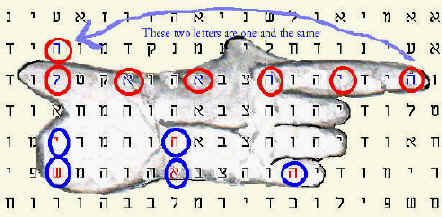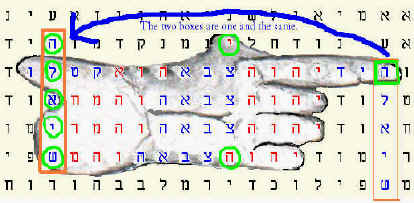Picture Bible Code Prophecy
The "I AM that I AM" Riddle
(Last of 3 parts)
The Large Wheels
|
Also see, The Leprous Hand
|
||
 |
 |
 |
Another riddle is put forth by means of three large wheels evenly spread across the hand.
Again, (as always) the wheels alternate in direction:"And so, is it the hand of Jehovah?
It goes to war, and the Father.
He will exalt (lift up) the One putting Him to death!" (
Ambiguous: 1. The Father indirectly had Jesus "lifted up" on the cross, 2. The Father "exalted" Him to His right side. 3. Jesus "exalted" the Father by His obedience unto death.)
The five corners of the hand contain this riddle:
Let us look again at the bible code of 23 circles. It mentions measuring at "a cubit and a cubit." The word 'cubit' is a play on words for "forearm" since the pictures are of two divided (half) forearms. This is to remind us of the "mene, mene," (tekel, uparsin) of Daniel---the words written on the wall. As Daniel said, mene means, "numbered," but the word also implies "measuring." "Mene" (mina) was also a unit of money---it was worth 60 shekels. The word "tekel" means "weighed" or, "a shekel." The word "parsin" means, "divided," or it can mean "a half-mina." All of these aspects are found in this bible code.
- Why the code is at an ELS of just ONE (letter-skip):
The entire bible prophecy code is found at an ELS of +1. This is the lowest ELS possible. (The bible code is in Hebrew, but the actual text of Daniel is in "Aramaic.) That is, the text reads letter by letter (spaces removed), rather than skipping over letters. The main code, which forms the hand, is at +1 ELS for this very reason: The "tekel" written on the wall by the hand of God was likewise worth but one shekel (of money).
- Why the code is 60 letters high and wide:
That this is why the ELS is at +1 is borne out by the fact that from the tip of the index finger to the far corner bottom left are exactly 60 letters of text. Thus, the length of the hand is 60 letters wide---corner to corner. Now, the "mene" was worth 60 shekels in Babylon!
But "mene" was written two times on the wall:
Whereas the length of the hand is 60 letters wide, the width is also 60 letters high (on the 15-ELS matrix) from the thumb to the bottom. Hence we have a 'mina and a mina.'
It is the dividing ('uparsin') of this mina that contains the most remarkable riddle of the code. For hidden within this hand is another complex bible code that uses an ELS of multiples of 5, for a total of 60, spanning precisely the said length of the hand.
We already saw that the five corners of the hand says, "They will be Who they will be, which is the Lord." "Jesus is Lord!"
Starting from the bottom left corner, and ending at the top right letter on the index finger, it reads: "What I am, I will not be."
Here we have a most amazing riddle. The bible code answers its own riddle with a question: "Will (he be changed) into a man?"
But the way it asks and answers this riddle is most amazing!
As said, the mina was worth 60 shekels and the 60 letters of the hand in width and length represents the 60 shekels of the mina/mina. But what about the 'peres' (i.e., uparsin)---the dividing of the mina?
The prophet Ezekiel has the answer. He divides the mina (mina) into 3 parts:
" And the shekel shall be twenty gerahs: twenty shekels (20), five and twenty shekels (25), fifteen shekels (15), shall be your mina," (Ezk. 45:12).
(As an aside, click here for how mene, mene, tekel, peres in Hebrew
adds up to 1260 x 2 'gerahs'!)The following code works with the 14-letter matrix-hand as well. Here it is set to the 15-letter matrix so as to show the width of the hand to be 60 shekels/letters---the same as its length. Some of the letters are repeated. This is simply because, while the full frame here has 19 letters per row, yet the matrix is only at 15 letters per row---this means the computer matrix reverberates the extra letters.
This in no way alters the code.
Note how the code uses Ezekiel's very same dividing ('peres') of the mina: I.e., 20 + 25 + 15 shekels/letters = 60 shekels!
Starting bottom left we have
("What I am...") at 5-letter skips, (5 x 4 skips = 20). Then there is a gap of 25 letters and then the code resumes
("I will not be"), at 3-letter skips, (3 x 5 skips = 15). Thus the riddle reads:
, "What I am, I will not be."
But how can such a statement apply to the immutable God?
The only logical answer to this riddle appears when the very same letters are read in reverse, this time at 15 letter skips:
, "Will He become a man?" (15 x 4 = 60).
Therefore, the hand that wrote mene-mene-tekel-peres on the wall is itself constructed according to the meaning of each of these same four coins!
Jesus asks a similar riddle in the book of John, only there it was about His death and resurrection rather than His incarnation. ("Incarnation" simply means, 'God becoming a man.')
"Then some of his disciples said to one another, "What does he mean by saying to us, 'A little while, and you will no longer see me, and again a little while, and you will see me'; and 'Because I am going to the Father'?" They said, "What does he mean by this 'a little while'? We do not know what he is talking about." Jesus knew that they wanted to ask him, so he said to them, "Are you discussing among yourselves what I meant when I said, 'A little while, and you will no longer see me, and again a little while, and you will see me'?" (Jn. 16:17-19)
See also the mene-tekel bible code



